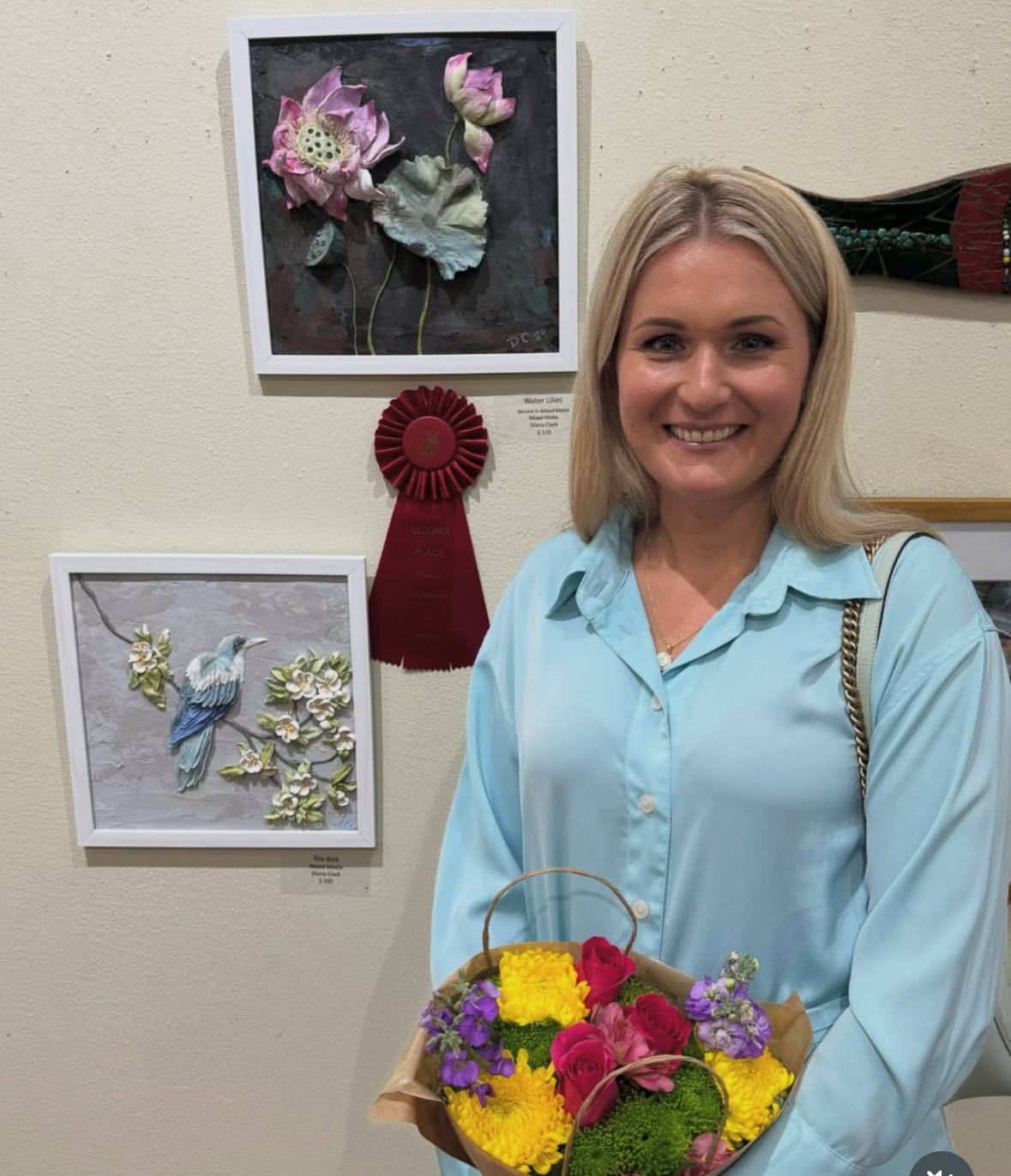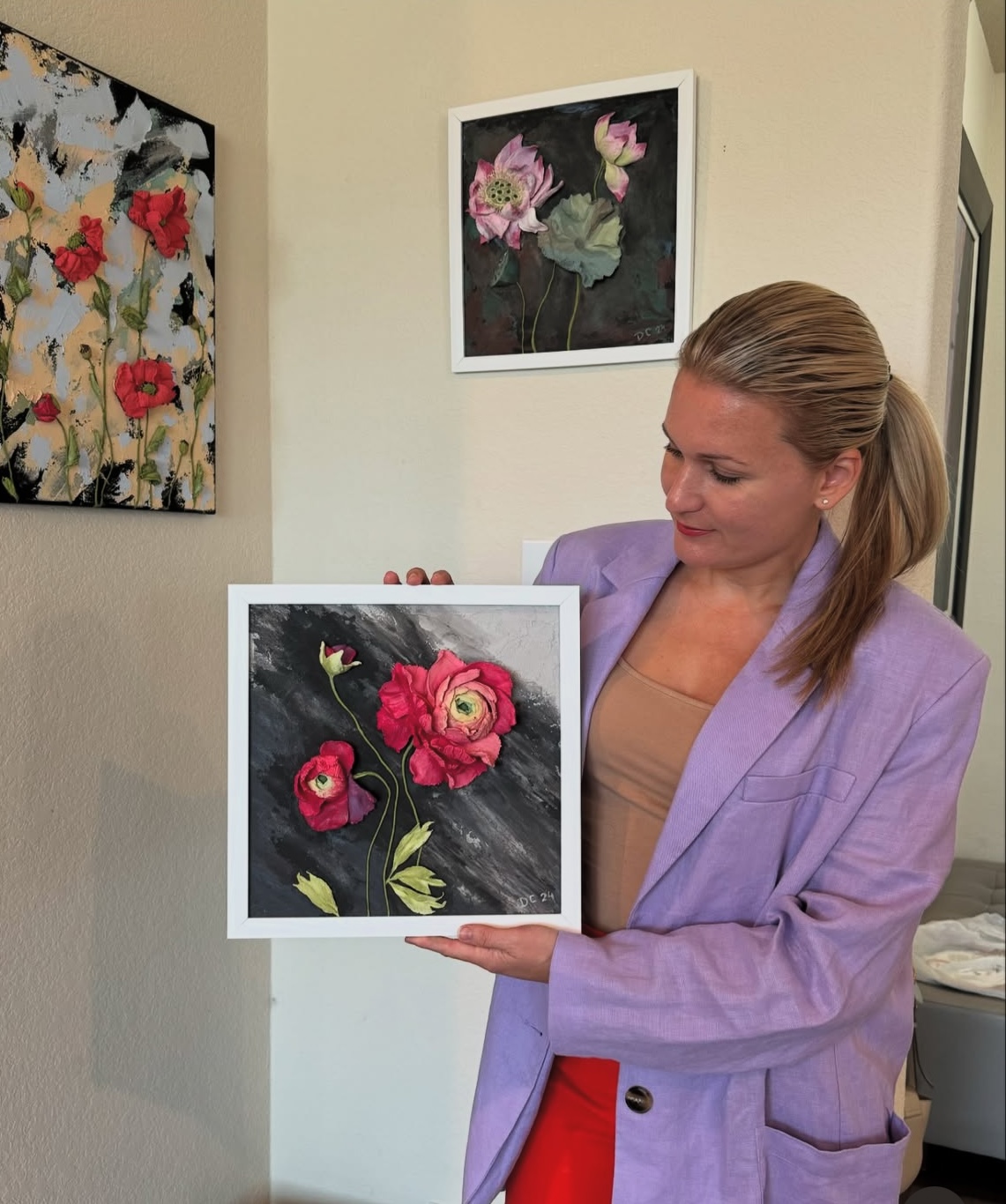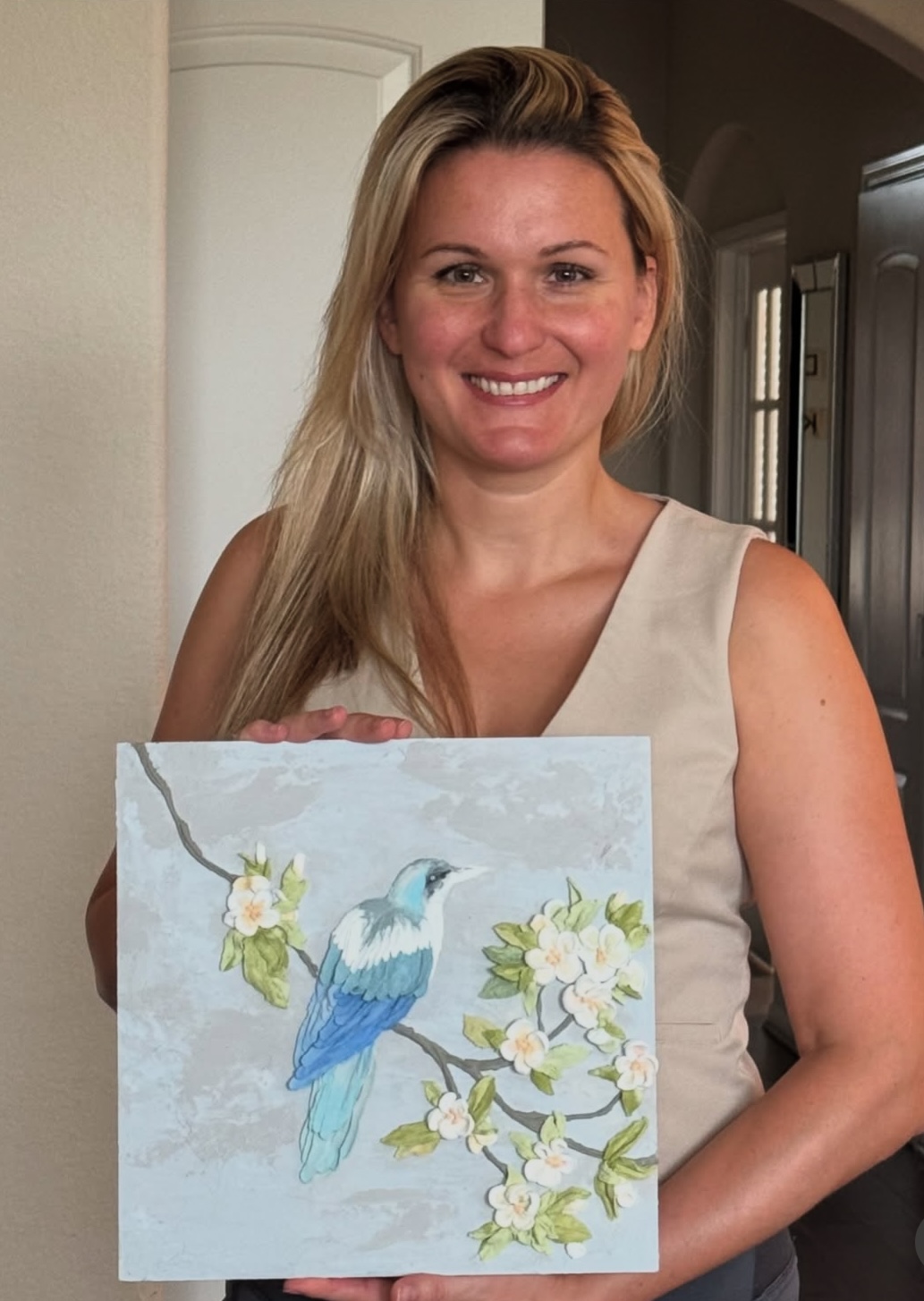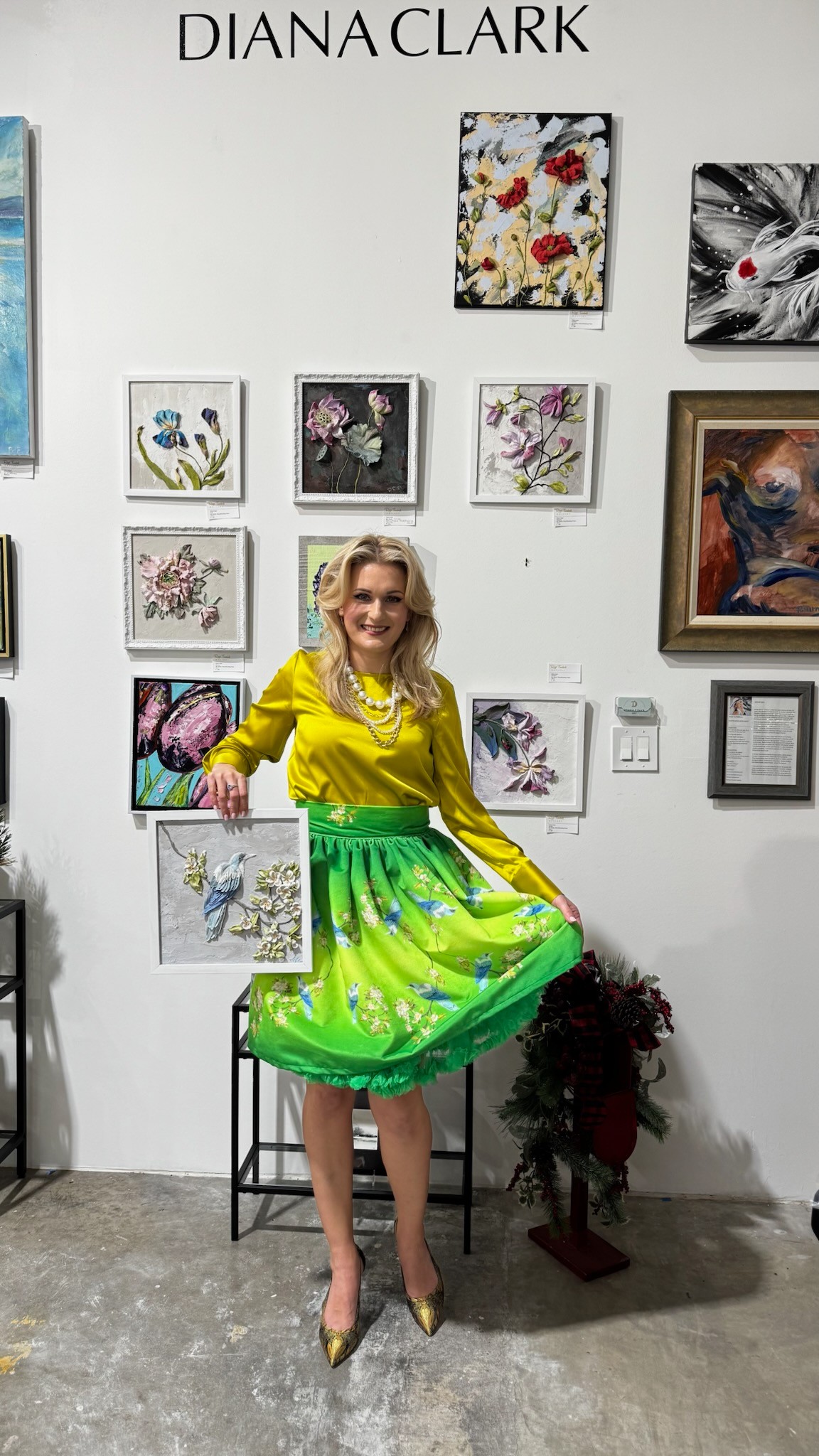We caught up with the brilliant and insightful Diana Clark a few weeks ago and have shared our conversation below.
Diana, thanks for joining us, excited to have you contributing your stories and insights. We’d love to hear about when you first realized that you wanted to pursue a creative path professionally.
It all started as a happy accident. In 2017, a friend invited me over for a casual painting session at her home. At that time, my artistic experience was limited to basic pencil sketches—the kind we all did in school. But that day, something shifted.
The first thing I painted was water. It was a simple piece, yet something magical happened. I instinctively used my fingers to blend the colors, and suddenly, I felt an unexplainable connection—as if it was just me and the painting, with everything else fading into the background. It wasn’t about the technique or the final result; it was about the sheer energy of creating.
I was completely immersed, probably looking a little crazy in the process—but I didn’t care then, and I don’t care now. That was the moment I knew art was more than just an activity; it was something deeply fulfilling, something I wanted to explore further.
Shortly after, I took a seasonal job at the Museum of Fine Arts, Houston, working at the Van Gogh exhibit. Surrounded by masterpieces every day, I felt my passion deepen. Art was no longer just about making something beautiful—it was about understanding its depth, its power, and its ability to move people. That experience solidified my decision to pursue art professionally, and I’ve never looked back.

As always, we appreciate you sharing your insights and we’ve got a few more questions for you, but before we get to all of that can you take a minute to introduce yourself and give our readers some of your back background and context?
My name is Diana Clark, and I’m a Houston-based artist specializing in both two-dimensional and three-dimensional art. My work spans multiple mediums—sculptural painting, oil, acrylic, pencil, and charcoal—each one allowing me to explore texture, depth, and movement in unique ways. My goal is to create immersive pieces that invite both sight and touch, drawing viewers into an expressive experience.
My journey into the art world was unexpected but transformative. What began as a casual painting session turned into a lifelong passion. Working at the Museum of Fine Arts, Houston, fueled my curiosity and led me to formalize my education. I pursued an art certification at the Glassell School of Art (under the Museum of Fine Arts, Houston), where I continue to take classes today. I’ve also expanded my skills through courses at the Glasscock School of Art and various online sculptural training programs.
Over the years, I’ve had the honor of exhibiting my work in multiple Houston galleries, including:
• Art League of Baytown Gallery
• Galveston Art League Gallery
• Rozi Turnbull Gallery – Located in Houston’s vibrant Sawyer Yards Art District (First Industrial Studios)
One of my proudest achievements has been developing Dianique, my own sculptural paste that enables artists to create three-dimensional paintings. In 2024, I was honored to receive 2nd place in the Mixed Media category for my piece Lilies at the Galveston Art League’s Fall Juried Show. Beyond my own creative work, I use art as a means of healing and empowerment, developing specialized art programs for children through the PEACE nonprofit organization.

In your view, what can society to do to best support artists, creatives and a thriving creative ecosystem?
Supporting artists requires a layered approach—education, funding, community engagement, and accessibility. Here are some key ways society can nurture a thriving creative ecosystem:
🎨 Increase Funding & Grants – Many artists struggle financially while dedicating time to their craft. Expanding grants, sponsorships, and residencies can provide essential resources.
🎨 Make Art Education More Accessible – Investing in early arts education fosters creativity and ensures future generations continue to value and pursue artistic careers.
🎨 Provide Affordable Studio & Exhibition Spaces – Subsidized studio spaces, pop-up galleries, and community art hubs can give artists more opportunities to create and showcase their work.
🎨 Encourage Public Art & Creative Initiatives – Public art projects not only beautify spaces but also create jobs for artists and make art more accessible to the public.
🎨 Support Local Artists & Businesses – Purchasing original artwork, attending exhibitions, and commissioning custom work helps sustain independent artists.
🎨 Leverage Technology & Digital Platforms – Helping artists expand their reach through social media, digital platforms, and virtual exhibitions can bring their work to a wider audience.
🎨 Recognize Art’s Role in Well-being – Art is essential for emotional expression, mental well-being, and cultural identity. Integrating art into healthcare, therapy, and community programs can amplify its impact.
By investing in artists and making creativity an integral part of daily life, we can build a world where artists are valued, supported, and empowered to share their vision.

What’s a lesson you had to unlearn and what’s the backstory?
One of the biggest lessons I had to unlearn was the idea that art must be “perfect” to be valuable.
The Backstory:
When I first started my artistic journey, I thought that the more flawless a piece looked, the more valuable it would be. But that mindset was holding me back. Instead of experimenting and taking risks, I spent too much time overanalyzing, correcting, and second-guessing my work.
Perfectionism became a box, limiting my creative growth. Ironically, instead of making me better, it slowed me down. I wasn’t evolving because I was too focused on getting everything “just right” rather than letting the creative process unfold naturally.
Then, I had a realization: some of the most expressive and moving pieces embrace raw textures, organic movements, and spontaneous strokes. Imperfections add depth, personality, and character to art. When I finally let go of control and trusted the process, I found freedom, growth, and a deeper connection to my work.
Now, I celebrate imperfections, and I encourage my students to do the same. Art isn’t about perfection—it’s about expression, exploration, and evolution. The moment I stopped chasing perfection, I truly started growing as an artist.
Final Thoughts
Art is more than just creating something beautiful—it’s about storytelling, connection, and emotion. Whether through my own work, my sculptural paste Dianique, or my nonprofit initiatives, I strive to push artistic boundaries while making creativity more accessible to others.
To those pursuing their own creative path: embrace the imperfections, take risks, and trust in the magic of the process. The best art comes from a place of authenticity and passion.
Thank you for taking the time to explore my journey. I look forward to continuing to create, inspire, and share this artistic adventure with you!
Contact Info:
- Website: https://www.dianaclarkart.com
- Instagram: https://www.instagram.com/diana_clark_art/
- Facebook: https://www.facebook.com/dianaclarkart



